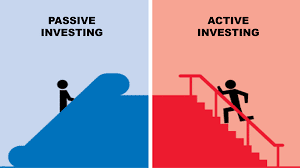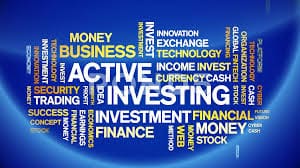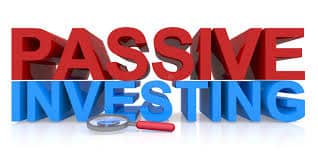Investing: Passive versus Active
When it comes to investing, several approaches can be taken. We have previously discussed the concept of growth versus value as part of a stock-picking portfolio. We will now look into the approaches available for managing investments. For that, we discuss the concepts of active investing and passive investing.

Active investing involves actively buying and selling individual stocks and investments, often via a portfolio manager, in an attempt to outperform the market. It can probably be best described as being a “hands-on strategy”. The opposite of this is passive investing. This takes a different approach, with more of a buy-and-hold mentality, using index funds rather than picking individual stocks. With that in mind, it could be described as “hands-off investing”.
We will now explain in a bit more detail each of these styles of active and passive investing, looking at some of the important pros and cons of each.
What is active investing?
First of all, let’s start with active investing. Active investing is all about striving for outperformance versus the market. In theory, this is achieved through stock-picking individual investments. Investments are chosen because they are seen as opportunities to outperform the market.
It is possible for investors to actively manage their own portfolio, however often the skills of a fund manager are employed to help achieve outperformance. Individual investors will tend not to have the time or expertise to manage their investments and successfully outperform. Subsequently, they will often place their investments with professional portfolio managers who are better equipped to achieve the goal of outperformance.
A fund manager will look to use their skill and experience in addition to internal expertise such as research teams to find the stocks and time investments that will beat the market. Investment and asset allocation committees within investment management companies will decide the best investments for the clients. The manager will then actively trade in and out of investments, looking to use timing skills to help generate outperformance. With a team of professionals actively helping to manage client portfolios, the theory is that the pool of knowledge will greatly increase the potential for portfolio outperformance.

Active investing pros and cons
There are a few important benefits that come from active investment management:
- Flexibility – Managers can shift the focus of the investments as markets turn. If equity markets take a turn for the worse, asset allocations can be moved into cash or bonds for more defensive positioning. Once markets begin to turn more positive again, a nimble fund manager can switch asset allocation back into equities and other higher-performing assets. The skill comes in knowing when moves lower are just a blip or when markets are turning decisively. The skill also comes in knowing when to position a portfolio to take the most advantage of bullish markets. Knowing when to shift a portfolio weighting out of defensives and into higher growth investments can be the difference between outperformance and underperformance.
- Hedging portfolios – If a portfolio is actively managed then the fund manager can use a variety of investment products to protect the portfolio from the downside. Hedging strategies can be used such as buying index put options or even shorting stocks can be put to work. Although there are costs and risks associated with using these products, the expertise of the fund manager can mean that hedging techniques offer a significant buffer to market downturns.
However, some negative aspects need to be considered too for active investing:
- Costs – The costs of active investing are much higher than passive. For an actively managed ETF or mutual fund, the total expense ratio (the total of all the costs of running the fund as a proportion of the funds under management) is often over 1%. For hedge funds, the old “two and twenty” model comes in (2% management fee plus 20% of any profits). This can quickly eat into the returns for the investor.
- Overtrading – The active manager of a fund can fall into the trap of overtrading in an attempt to achieve outperformance. Especially if markets are moving sideways, buying and selling to achieve outperformance can achieve very little other than to increase the costs of trading.
- Risk – Active portfolios that are positioned for outperformance can often be those that are most susceptible during a downturn. This can quickly drive a significant drawdown in a portfolio.
- Timing errors – This is an extension of the risk aspect. There is an old saying that markets take the escalator higher but then take the lift back down. If the fund manager is aggressively positioned for outperformance and markets do turn quickly, then they can quickly find positions facing hefty losses. These losses can rack up if they are slow to unwind their investments.
What is passive investing?
Passive investing involves replicating the returns of the market. The investor uses a buy-and-hold approach, preferring long-term investments such as index funds that track market moves. There are no individual stock investments as this would skew the diversification.
The passive investing strategy can involve gaining exposure to different markets, but the investments in these markets tend to be in exchange traded funds (ETFs) that aim to replicate the performance of the whole market.
The investor might look to buy an S&P 500 Index ETF to have exposure to US equities, or a FTSE 100 Index ETF to have exposure to UK equities. The ETF simply tracks the performance of the market because it invests in all of the companies in the index. There are very few changes to the fund (for example, with UK equities there is a quarterly reshuffle of the FTSE 100 components) so very few transactions are required. This helps to keep the running costs of the ETF down.

Passive investing pros and cons
Here are some key advantages of passive investing:
- Very low costs – The costs of owning passive ETF investments are much lower than for active funds. There is no stock-picking fund manager, no research teams to pay for and very limited transaction costs. Subsequently, there are much lower fees. The total expense ratio of a passive ETF can often be less than +0.1% per annum.
- Lower risk – The exposure to the whole market means that there is much greater diversification in passive investing. This means that individual investments are not going to make or break your account, as can be the risk with active investing.
- Better transparency – You know what you are going to get with passive investing. The one aim is to track the index. With active investing, you never really know where you are invested as it is mostly left to the discretion of the manager. This can sit uncomfortably with some investors. That is not the case with passive investing.
As ever, there are always a few disadvantages too though:
- A limited pool of investments – the fund will only own investments that are present in that index. This limits any potential variance, whilst investors are locked into investments whether they agree with the ethics and ethos of the business or not.
- You are locked in if the market turns – You’re there for the long haul, for good and bad. If there is a big swing lower in markets, you have to ride out the move (unless of course, you close your position in the fund). Unlike active investing, there is no prospect of defensive strategies, such as moving into cash or bonds or using put options to hedge the position. It could take a long while, sometimes years for the market to recover from some sell-offs.
- Limited returns – A fund that tracks the market will only ever produce a performance that is close to that of the market. It is not investing that will get the heart pumping (yes, some people like the excitement). Passive investing is very much a slow and steady race.
Active or Passive?
So then, active or passive? When it comes to deciding, there are many factors to consider. Factors such as the type of investor you are, how much time you have to commit and how long you are looking to invest should all be considered.
Passive investing is becoming increasingly popular. According to Bloomberg, passive investments account for around 15% of the total market capitalisation in the US stock market. Also, when it comes to equity funds, with the significant growth in the number of index funds tracking US equity markets, passive funds have now overtaken actively managed funds.
Studies have shown that the returns that active investment strategies do not consistently outperform the market. Equity markets fell significantly in 2022, a time when the flexibility of active investing should be prime to outperform by using defensive strategies and hedging. However, according to analysis from Morningstar, in the US, active fund managers were unable to achieve significant outperformance. Only 40% outperformed passive funds in the 12 months to June 2022. Picking the right fund manager is important in active investing.
Choosing active over passive may also depend on your investment focus too. If you are looking to trade large-cap equities, then these are stocks covered by pretty much every fund manager out there. There is very little that a research team will be able to glean from a stock that is not already known by the market. This is very much in the realm of the Efficient Market Hypothesis territory. Everyone knows everything, therefore, the shares tend to be priced at (or fairly close to) a fair value. If outperformance is inherently difficult, then a passive fund might be seen as safer and a more dependable investment.
However, if you are looking more into smaller capitalised equities, then there might be some advantage that comes from active investing. Fund managers that specialise in finding the “next big thing”, or a “diamond in the rough”, can generate the sort of returns that justify the cost of expensively managed portfolios.
Passive versus Active Investing Takeaways
We have looked into passive and active investing, taking into consideration the pros and cons of each type. Investors can see what type of investing is suitable to their style, personality and commitment. With a balanced form of investing, maybe there is a blended approach that can be taken. One that uses a mix of both passive funds and active investments. However, as ever, if you are interested, we would suggest seeking independent advice first. We wish you good luck with your investing!